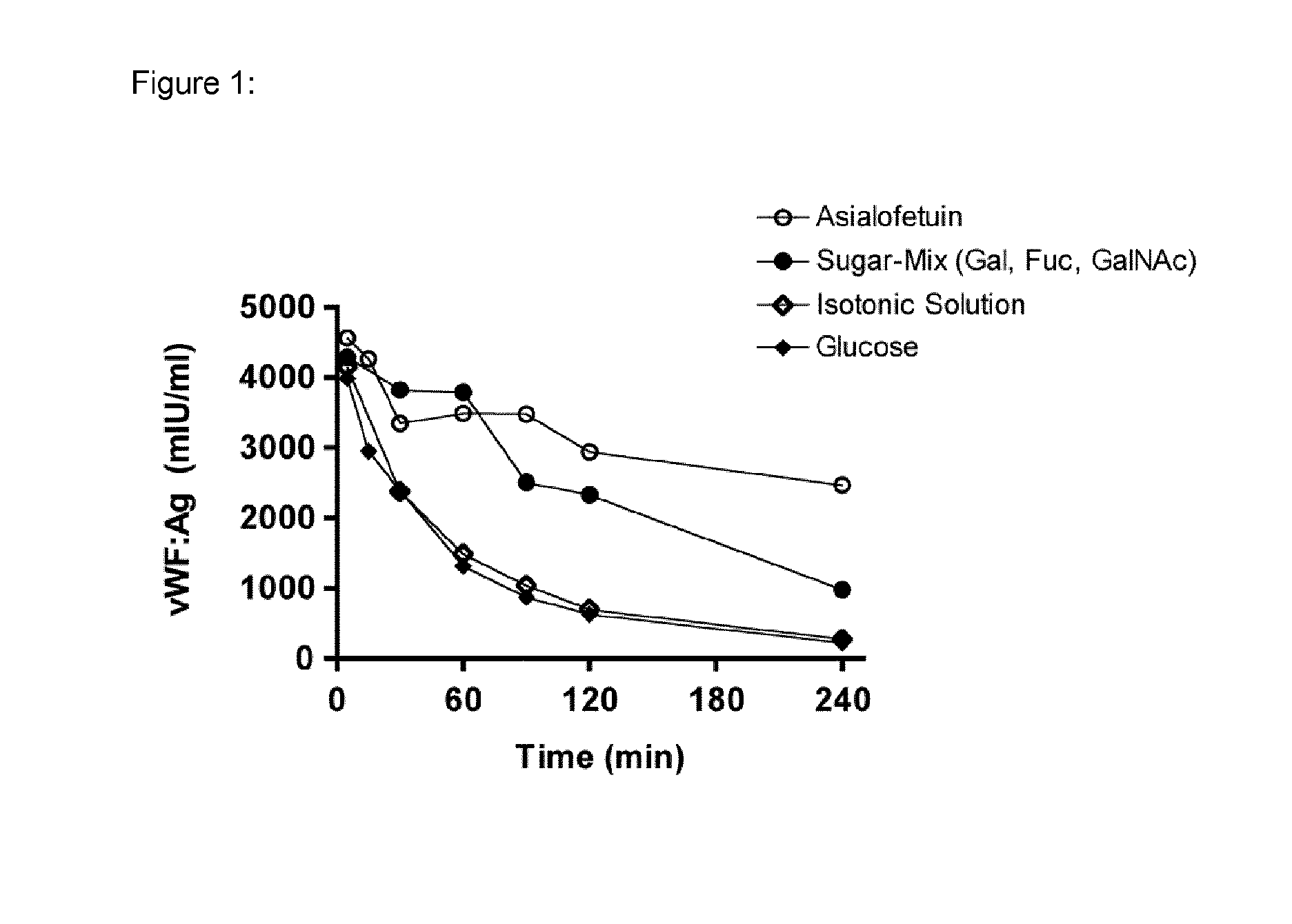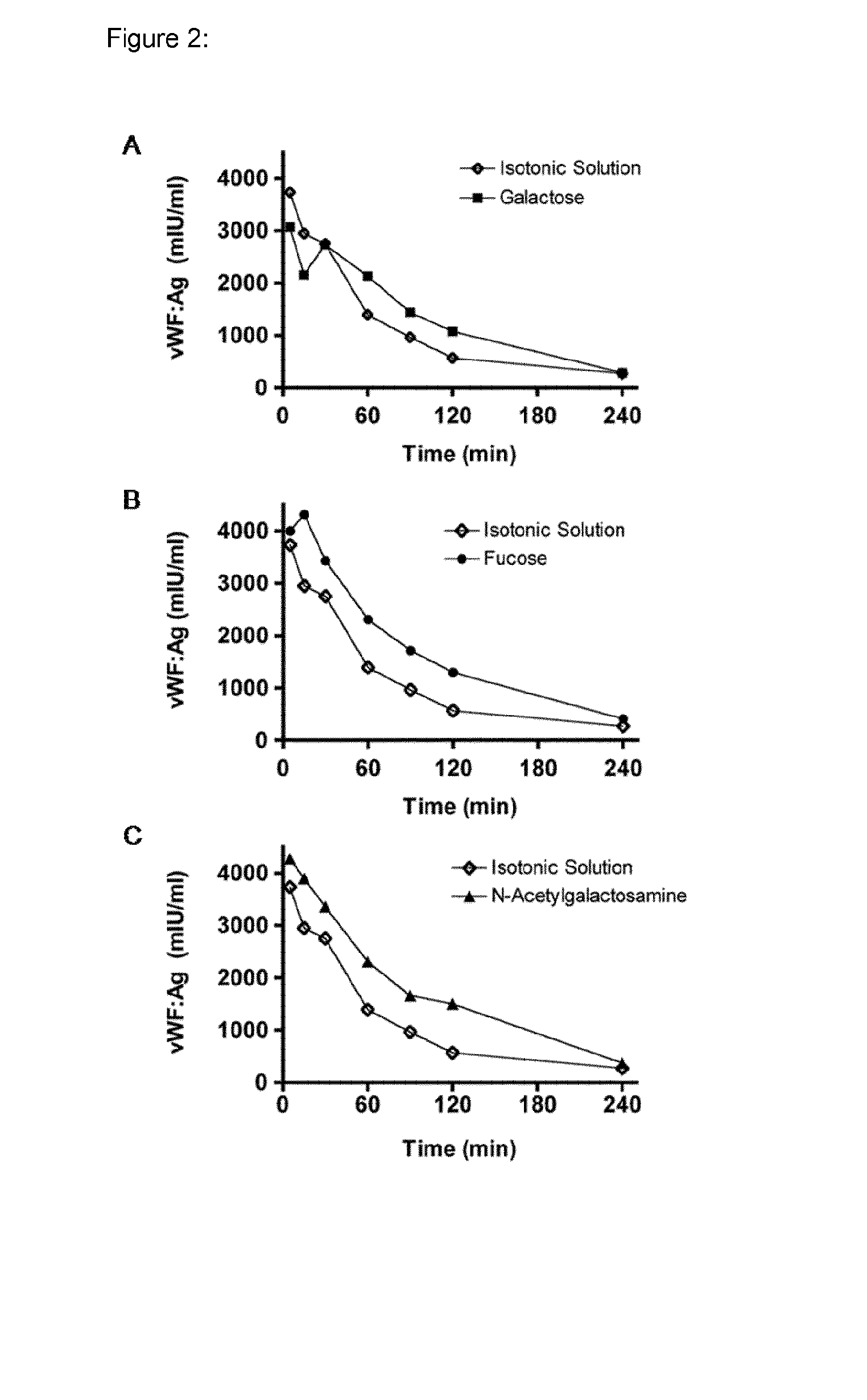Sugar Compositions for Treating Hemophilia A and/or Von Willebrand Disease
a technology for von willebrand disease and sugar compositions, which is applied in the direction of drug compositions, peptide/protein ingredients, extracellular fluid disorders, etc., can solve the problems of unfavorable detailed understanding of the process, and achieve the effect of reducing the clearance of vwf, and reducing the clearance of fviii
- Summary
- Abstract
- Description
- Claims
- Application Information
AI Technical Summary
Benefits of technology
Problems solved by technology
Method used
Image
Examples
example 1
Influence of Monosaccharides on the Clearance of Human Plasma-Derived VWF in Rats and Mice
[0054]Blood group sugars A, B and O(H) consist of three different monosaccharide units (for H only two); namely galactose (Gal), fucose (Fuc) and N-acteylgalactosamine (GalNAc). To evaluate the effect of these sugars on the clearance of pd-VWF, rats were injected i.v. with a bolus of a “sugar-mix”, consisting of Gal, Fuc and GalNAc, obtained from Sigma Aldrich, St Louis, USA, (each 2 g / kg) 15 minutes before infusion of Haemate® P (200 IU / kg) type O(H). Alternatively, each sugar was used individually at 2 g / kg. To avoid masking of the blood group antigens present on VWF by blood group-specific antibodies, material isolated from blood group type O(H) individuals was used. In addition, bovine asialofetuin (250 mg / kg), a described ligand for blocking the galactose receptors such as the ASGPR in the liver has been additionally used. Furthermore, glucose (2 g / kg) was included in the study as a negati...
example 2
Effect of Fuc, Gal and GalNac on the Clearance of Plasma Derived VWF in VWF-Deficient Mice
[0056]The effect of the sugars on the clearance of human plasma-derived (pd) VWF was also evaluated in VWF-deficient mice. The animals received a bolus of a “sugar-mix” i.v., consisting of Gal, Fuc and GalNAc (each 2 g / kg) 15 minutes before infusion of Haemate® P (200 IU / kg) type O(H). As shown in FIG. 3, a comparable effect as shown before in rats of the sugar-mix on clearance of pd-VWF was observed in VWF-deficient mice.
example 3
[0057]Specific sugar doses related to each of the approaches described above are evaluated in animal research models such as rats and / or VWF-deficient mice aiming to find the appropriate concentration for in vivo application. Different sugar concentrations are administered intravenously. For example, a range of sugar concentrations from 30 mg / kg to about 6 g / kg can be used, and the sugars are used individually and in combinations of two or all three sugars. Oral administration of the different sugar concentrations is also part of the investigation. Concomitantly to the sugar administration described, plasma derived or recombinant VWF or preparations containing both VWF and FVIII are co-administered; alternatively, the administration of VWF or VWF and FVIII is delayed by about 5 minutes following administration of the sugar(s). After administration, VWF antigen levels are continuously monitored by applying a standardized ELISA system. In case of FVIII administrati...
PUM
| Property | Measurement | Unit |
|---|---|---|
| temperature | aaaaa | aaaaa |
| pH | aaaaa | aaaaa |
| pH | aaaaa | aaaaa |
Abstract
Description
Claims
Application Information
 Login to View More
Login to View More - R&D
- Intellectual Property
- Life Sciences
- Materials
- Tech Scout
- Unparalleled Data Quality
- Higher Quality Content
- 60% Fewer Hallucinations
Browse by: Latest US Patents, China's latest patents, Technical Efficacy Thesaurus, Application Domain, Technology Topic, Popular Technical Reports.
© 2025 PatSnap. All rights reserved.Legal|Privacy policy|Modern Slavery Act Transparency Statement|Sitemap|About US| Contact US: help@patsnap.com



